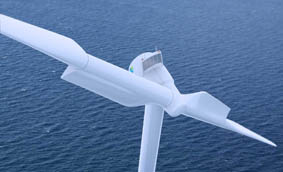Load Comparisons between a Partial Pitch Two-Bladed Turbine and a Three-Bladed Turbine
 This article shows the potential for reducing extreme loads with an innovative design of wind turbine, a partial pitch two-bladed concept turbine. The most extreme conditions to test a turbine are considered to be stand-still combined with a grid failure in which the wind comes from all directions from 0 to 360 degrees. All aeroelastic load simulations are done by using the aeroelastic code HAWC2. From the load comparisons between the partial pitch two-bladed turbine and a conventional three-bladed turbine it is observed that the partial pitch two-bladed turbine can reduce the extreme tower bottom bending moment by approximately 33% compared to the three-bladed turbine.
This article shows the potential for reducing extreme loads with an innovative design of wind turbine, a partial pitch two-bladed concept turbine. The most extreme conditions to test a turbine are considered to be stand-still combined with a grid failure in which the wind comes from all directions from 0 to 360 degrees. All aeroelastic load simulations are done by using the aeroelastic code HAWC2. From the load comparisons between the partial pitch two-bladed turbine and a conventional three-bladed turbine it is observed that the partial pitch two-bladed turbine can reduce the extreme tower bottom bending moment by approximately 33% compared to the three-bladed turbine.
By Taeseong Kim, Wind Energy Department, Technical University of Denmark Risø Campus, Denmark
 This article shows the potential for reducing extreme loads with an innovative design of wind turbine, a partial pitch two-bladed concept turbine. The most extreme conditions to test a turbine are considered to be stand-still combined with a grid failure in which the wind comes from all directions from 0 to 360 degrees. All aeroelastic load simulations are done by using the aeroelastic code HAWC2. From the load comparisons between the partial pitch two-bladed turbine and a conventional three-bladed turbine it is observed that the partial pitch two-bladed turbine can reduce the extreme tower bottom bending moment by approximately 33% compared to the three-bladed turbine.
This article shows the potential for reducing extreme loads with an innovative design of wind turbine, a partial pitch two-bladed concept turbine. The most extreme conditions to test a turbine are considered to be stand-still combined with a grid failure in which the wind comes from all directions from 0 to 360 degrees. All aeroelastic load simulations are done by using the aeroelastic code HAWC2. From the load comparisons between the partial pitch two-bladed turbine and a conventional three-bladed turbine it is observed that the partial pitch two-bladed turbine can reduce the extreme tower bottom bending moment by approximately 33% compared to the three-bladed turbine.By Taeseong Kim, Wind Energy Department, Technical University of Denmark Risø Campus, Denmark










